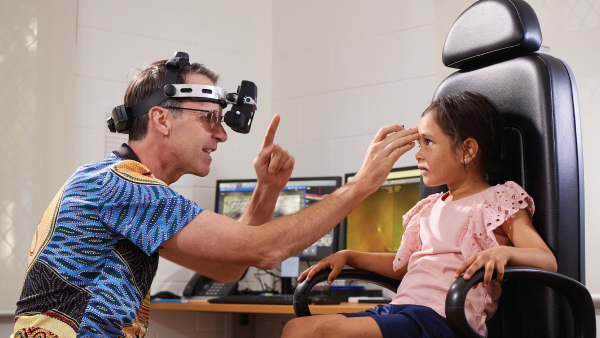Landmark nAMD Treatment
Could robot-assisted radiotherapy offer a new treatment choice for neovascular age-related macular degeneration?
For the majority of patients, neovascular age-related macular degeneration (nAMD) demands long-term management. Existing literature notes that the current cornerstone treatment for nAMD – intravitreal injections of anti-VEGF agents every one-to-three months – can be slightly more effective than a pro re nata (PRN) injection regimen (1).
But what if there was a way to further cut down intravitreal injection frequency for patients?
A research team at King’s College London has successfully tested a custom-built, robotically controlled device that administers three beams of highly focused overlapping radiation at the macula of patients.
In a randomized, sham-controlled trial designed to test efficacy of the device (2), the researchers enrolled 411 participants between 2015 and 2019, with 274 receiving the stereotactic radiotherapy (SRT) treatment and 137 receiving the sham treatment. The study, published in The Lancet, reported a 22 percent reduction in the number of ranibizumab injections required in the SRT patients; the researchers estimate that this treatment could potentially save 1.8 million injections per year globally.
“The key attraction [of SRT] is that it doesn’t involve an intravitreal injection and can be delivered in a simple, one-off, outpatient procedure,” explains study lead Timothy Jackson, a consultant ophthalmic surgeon at King’s College Hospital, London. “[And] it only needs to be delivered once, so thereafter we do not rely on patient compliance to drive efficacy.”
Even taking into account the cost of SRT treatment, in the UK (where the study was conducted) the reduced dosing of ranibizumab led to net cost-savings of around £565 per patient over a two-year period.
When it comes to the global future of the SRT device, Jackson is optimistic but cautious: “Research has previously tried to find a better way to target radiotherapy to the macula… but so far nothing has been sufficiently precise to target macular disease less than 1 mm across. With this purpose-built robotic system, we can be incredibly precise. However, the positive and negative effects of radiation can manifest over a long time horizon, so it will be important to review the year 3 and 4 data before advocating widespread adoption.”
This article first appeared in The Ophthalmologist.
References
- E Li et al., “Treatment regimens for administration of anti‐vascular endothelial growth factor agents for neovascular age‐related macular degeneration,” Cochrane Database Syst Rev., 5 (2020). PMID: 32374423.
- TL Jackson et al., “Stereotactic radiotherapy for neovascular age-related macular degeneration (STAR): a pivotal, randomised, double-masked, sham-controlled device trial,” The Lancet [Online ahead of print.] (2024). PMID: 38876132.
The New Optometrist Newsletter
Permission Statement
By opting-in, you agree to receive email communications from The New Optometrist. You will stay up-to-date with optometry content, news, events and sponsors information.
You can view our privacy policy here
Sign up to The New Optometrist Updates
Permission Statement
By opting-in, you agree to receive email communications from The New Optometrist. You will stay up-to-date with optometry content, news, events and sponsors information.
You can view our privacy policy here
Sign up to The New Optometrist Updates
Permission Statement
By opting-in, you agree to receive email communications from The New Optometrist. You will stay up-to-date with optometry content, news, events and sponsors information.
You can view our privacy policy here







